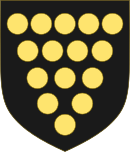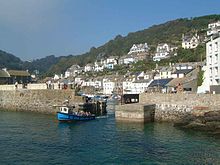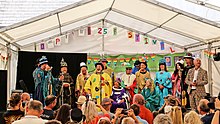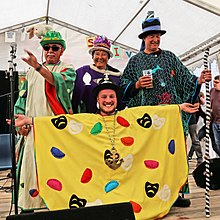Polperro
Polperro
| |
|---|---|
 | |
Location withinCornwall | |
| Population | 1,554 (Parish, 2001) |
| OS grid reference | SX207509 |
| Civil parish |
|
| Unitary authority | |
| Ceremonial county | |
| Region | |
| Country | England |
| Sovereign state | United Kingdom |
| Post town | Looe |
| Postcode district | PL13 |
| Dialling code | 01503 |
| Police | Devon and Cornwall |
| Fire | Cornwall |
| Ambulance | South Western |
| UK Parliament | |
| Website | http://www.lovepolperro.com |
Polperro(Cornish:Porthpyra,[1]meaningPyra's cove) is a large village,civil parish,and fishingharbourwithin the Polperro Heritage Coastline in south Cornwall, England, United Kingdom. Its population is around 1,554.
Polperro, through which runs theRiver Pol,is 7 miles (11 km) east ofFoweyand 4 miles (6 km) west of the neighbouring town ofLooeand 25 miles (40 km) west of the major city andnavalport ofPlymouth.It is a noted tourist destination, particularly in the summer months, for its idyllic appearance with tightly-packed ancientfishermen'shouseswhich survive almost untouched, its quaintharbourand attractive coastline.
History
[edit]Toponymy
[edit]The namePolperroderives from theCornishPorthpyra,meaningharbour named afterPyran.[2]HoweverEkwallsuggests that "Pyra" or "Pira" may not be a personal name and suggests that "Perro" could be a name for the stream. Early forms arePortpira,1303, andPorpira,1379.[3]The chapel ofSt Peterde Porthpyre is mentioned in 1398 and the following forms are recorded from the reign ofKing Henry VIII:Polpyzexplained as "fish-pool" (probably a literal error forPolpyr),Poulpirrhe,Poul PierandPoulpyrre(inJohn Leland's account).[4]
Early history
[edit]Polperro, since medieval times, fell under the jurisdiction of two ancient and separatemanors,those of Raphael[5]in the parish ofLansallos,west of theRiver Polwhich runs through the middle of the village, and Killigarth to the east in the parish ofTalland,[6][7]mentioned in theDomesday Book.
As early as the 13th century Polperro was a recognised fishing settlement and its first known record is in aRoyal Ordinanceof 1303.
Later history
[edit]
The date of the building of Polperro's olderquayis uncertain butJonathan Couch(writing in the mid-19th century) considered that it is either the one mentioned byJohn Lelandor one built upon the same site. It was probably built under the patronage of thelord of the manorof Raphael who owned the harbour and its rights. Polperro's newer quay, also of unknown antiquity, is sited almost on an east-west alignment a little further out to sea. It was built before 1774 when it suffered much damage in a storm, following which Thomas Long, ofPenhealeand lord of the manors of Raphael and Lansallos, paid for its repair.
Parts of the harbour were rebuilt after destruction by a violent storm on 19 and 20 January 1817, when thirty large boats, twoseinersand many smaller boats were destroyed with many parts of the village including theGreenand Peak Rock were consumed by the sea waters and a number of houses were swept away. The damage was estimated at £2,000 but there were no deaths.[8]This storm, with hurricane-force winds, caused damage to property from Plymouth toLand's End;the fishing boats at Polperro ″shared in the common calamity and exposed the unhappy sufferers to distress from which the industry of years can scarcely be expected to relieve them″.[9]
In November 1824 the worst ever storm occurred: three houses were destroyed, the whole of one pier and half the other were swept away and nearly 50 boats in the harbour were dashed to pieces. Of the six boats that survived, only one of which was a Gaffer. Polperro's new pier was designed to afford better protection for the future.[10]TheEast IndiamanAlbemarlewas blown ashore with a valuable cargo of diamonds, coffee, pepper, silk and indigo on 9 December 1708 near Polperro (the precise location of the wreck is yet to be discovered).[11]
Jonathan Couchwas the village doctor for many years, and wrote the history of the village as well as various works of natural history (particularly onichthyology). TheHistory of Polperro,1871, was published after his death by his son, ThomasQuiller Couch,with many abridgements since. Couch contributed two series of articles to the periodicalNotes and Queries–The Folklore of a Cornish Village1855 and 1857, and these were incorporated in theHistory of Polperro,to which he also contributed a sketch of his father's life. The welfare of the fishermen and the prosperity of the fisheries were in his care together with his medical and scientific work.[12]
Polperro's beauty has long been a magnet for artists. The celebrated Austrian painterOskar Kokoschka,upon discovering Polperro, spent a year in the village between 1939 and 1940.[13]It also features as a location for filming theTV drama series,Doc MartinandBeyond Paradise.
Smuggling
[edit]
Smugglingis understood to have prospered since Polperro developed as a port in the 12th century.[14]It reached its zenith in the late 18th century when Britain's wars with America and France precipitated the high taxation of many imported goods, making it worthwhile for the local fishermen to boost their income by the covert importation ofspirits,tobacco and other goods fromGuernseyand elsewhere. By the late 18th century, much of the success of the smuggling trade through Polperro was controlled by Zephaniah Job (1749–1822), a local merchant who became known as the 'Smugglers' Banker'.
A more organisedCoast Guardservice was introduced in the 19th century together with the deterrent of stiff penalties, leading to much less smuggling. Part of the South West Coast Path was originally used by Revenue Officers as they patrolled the coast in search of smugglers. Whilst theSouth West Coast Pathis maintained by theNational Trust,theforeshorebelongs to theDuchy of Cornwall.
Robert Jeffery
[edit]In 1807, onCommanderWarwick Lake's[15]HMSRecruit,Robert Jeffery, a Polperroite, was found to have stolen his midshipman's beer, and Lake, in a fit of pique, ordered him to bemaroonedon the island ofSombrerooffAnguilla.Jeffery was born inFoweybut moved to Polperro before joining the merchant navy and then being press-ganged into the Royal Navy.[16]
Some months later, Lake's commanding officerSir Alexander Cochranelearned of what had happened and immediately ordered Lake to retrieve Jeffery. WhenRecruitarrived at Sombrero, Jeffery could not be found. Eventually the story got out and Lake was discharged from the Royal Navy by court martial for his actions. As it turned out, Jeffery had been rescued by an American ship and was discovered inMassachusettsthree years later, working as ablacksmith;he was repatriated to Britain and awarded compensation.[17][18]
Economy
[edit]Tourism
[edit]
Tourism became Polperro's main industry during the 20th century. The village is accessible by air via Plymouth orNewquay,by train viaLooe railway station,by road and by boat. It was estimated that the village received about 25,000 visitors a day during summer in the 1970s.[19]Visitors are no longer permitted to drive cars into the village, having to leave them in the main car park atCrumplehornto the north of the village and walk through the half-mile length of the village to its harbour. The village's quaint but narrow streets make driving difficult. There are horse and cart rides andmilk floatsdisguised as trams for those who prefer not to walk.
Attractions of Polperro include the South West Coast Path, the 630-mile (1,010 km)-long and established walk fromDorsettoSomersetwhich passes through the village, and offers day walks along the local scenic coastline, in particular to nearbyTalland Bayon the coast path heading East. Westwards, the path passes three large beaches en route toFowey:Lansallos Beach, Lantivit Bay and Lantic Bay.[20]Within the village is the Polperro Heritage Museum of Fishing and Smuggling,[21]situated on the harbourside in an oldfish processingwarehouse,which houses interesting photographs of the village's history among other popular displays. Guided walks are available in the village, and boat trips can be taken from the harbour to view the coastline which can offer sightings ofdolphinsandseals.
The village has several restaurants as well as seven pubs. A holiday andcaravan parkis situated outside the village to the northeast atCarey Park.
Fishing
[edit]
Fishingwas traditionally the principal occupation of Polperro families.[22]For centuries the village has been apilchardfishing and processing port. Fish are drawn for feeding off the South Cornwall coast in late summer bringing rich pickings for local fishermen. Once ashore, the fish were salted and pressed and the oil was collected as a by-product and used for heating and lighting. Polperro pilchards were exported throughout Europe.
Shoals of these fish diminished in the 20th century and pilchard fishing died out as Polperro's mainstay in the 1960s, however approximately twelve commercial fishing vessels still operate from the harbour catchingflatfish,scallops,crabs,monkfish,ray,pollock,bassandcod.Fresh fish and seafood are available for purchase at the quayside from time to time.
Festivals
[edit]Other than traditional festival days, The Polperro Festival has been held annually since 1996, being a community festival run by volunteers beginning on the 3rd Saturday in June which helps to promote business for the village.[23]It started as anArts and craftsFestival,and has developed to include live music of many genres, dance, street entertainment, theatre and children's entertainment and local food. Most of the entertainment centres on Big Green, the village square, and for the last few years under a covered marquee. After 9 pm, for noise considerations, the festivities at Big Green disperse elsewhere.
Lord Mayors
[edit]As part of the Polperro festivities, aLord Mayoris chosen in secret and revealed on the main stage on the first Saturday. Their identity is kept secret until the reveal and they are brought out wearing an outfit that best represents them and what they are recognised for within the village. The Lord Mayor is then paraded through the village accompanied by their "Merry Men" where they go to every pub and inn to taste the ale, to make sure it is suitable for the village for the upcoming year. Once they have visited all the pubs and inns, they are then brought down the beach where they "meet the tide". This marks the opening of the festival and traditionally was meant for the village drunk or local idiot where they would throw them in the harbour in an attempt to sober them up.

Past Lord Mayors of Polperro
[edit]Here is a current list of all the previous Lord Mayors of Polperro since its conception in 1996:
1996 - Ashley Courts
1997 - John Holden
1998 - Brenda Thomas
1999 - Joe Card
2000 - Chris Pannewitz
2001 - Terry Bicknell
2002 - Gilly Davis
2003 - Martin "Beaver" Thomas
2004 - Alun "Pendragon" Thomas
2005 - Ted Pilcher
2006 - Glenda Taper
2007 - Erica Gregory
2008 - John "Grandad" Marshall
2009 - Alan "Coach" Morris
2010 - Robert Chisman
2011 - Tony White
2012 - Sam Baker
2013 - Nathan "Small" Toms
2014 - Franco Miceli
2015 - Abbi Rendell
2016 - Brian & Rita Morgan
2017 - Gina Farrell
2018 - James Overton
2019 - Mike Jelly
2022 - Phil Thomas
- Note: There was no festival held between 2020 & 2021 due to the COVID-19 pandemic. Instead Mike Jelly held onto the Lord Mayor title until handing over to Phil Thomas in 2022.

History of the Lord Mayoralty
[edit]Ashley Courts was the first Lord Mayor of Polperro and first male Lord Mayor. Brenda Thomas was the first female Lord Mayor. Martin "Beaver" Thomas was the second member of the same family to be Lord Mayor (Thomas '98). Brian & Rita Morgan were the first duo to serve jointly as Lord Mayor. Mike Jelly was the first Lord Mayor to hold onto the title for more than one term. Phil Thomas was the third member of the same family to be Lord Mayor (Thomas '98 & '03).
Lord Mayor's money, portrait and Lord Mayor's Ball
[edit]In addition to his ceremonial robe and hat, commemorative money is printed featuring the Lord Mayor's face. This money is not legal tender being strictly for commemorative purposes and has no real value within the village anymore. They are also presented with a portrait painted by a local artist which is displayed the following year of their term as Lord Mayor, each Lord Mayor serves only for one year (with the exception of Mike Jelly due to the COVID-19 pandemic) and it is their job to open new businesses throughout the year and also be present at any other activities or festivities happening within the village during their term of office. As a result, a Lord Mayor's Ball is held in their honour, usually around April time, which is a night held for festivities and merriment. The current Lord Mayor can choose what band is to be played and in recent years will choose a theme for patrons to dress up. All money raised on this night is then donated back in the Polperro Festival Fund ready for the next year's festival and incoming Lord Mayor.
Notable buildings
[edit]
Couch's House in Lansallos Street was home tonaturalistand physician,Jonathan Couchand before him of many generations of the Quiller family who became prosperous through the proceeds of smuggling andbuccaneering.[24][25]
Polperro'sWar Memorialis some distance outside the village on the coast path towards Talland. Also, tucked away in the village's winding streets (on "The Warren" ), is a house clad entirely inshells,known colloquially as "The Shell House".[26]
Churches
[edit]Situated in theAnglicandiocese of TruroPolperro, although a small village, is served by twoChurch of Englandparishes divided by the River Pol:Lansallosto the west andTallandto the east. The 19th-century Anglican Chapel of St John, achapel of easetoTalland Parish Church,stands in the village but no longer conducts services.John Wesleypreached in the village in 1762 and 1768: by 1792 it was possible to build a large chapel accommodating 250 people andMethodismflourished in Polperro during the 1800s.[27]
Sclerder Abbey,aRoman Catholicmonastery,is located off the road toLooe,just outside the village.[28]
Science
[edit]
In the late 19th century,Sir Francis Galtonconducted a study offingerprintsat Polperro. He chose the village because of the prevalence ofintermarriageamongst its inhabitants, being only accessible from the sea or by coastal path at that time. His findings helped to advancecriminologyand sociology and include extensivegenealogiesof local families which are held at theCollege of Armsin London.
Notable residents
[edit]- Donald Adamson,author and historian
- Angela Brazil,novelist
- Anyon Cook,illustrator for Enid Blyton.[29](Harbour Studio)
- Jonathan Couch,naturalist, physician and antiquary
- Walter Greenwood,novelist, lived in Polperro briefly during the 1930s and founded the production company,Greenpark Productions,there in 1938.[30]
- Zephaniah Job, "The Smugglers' Banker"[31]
- Oskar Kokoschka,artist
- Rita Tushingham,actress lived in the village in the 1970s.[32]
- Hugh Walpole,novelist
Council
[edit]Polperro Community Council is the lowest level of government for theparish.[33]
References
[edit]- ^"List of Place-names agreed by the MAGA Signage Panel"(PDF).Cornish Language Partnership. May 2014. Archived fromthe original(PDF)on 29 July 2014.Retrieved11 January2015.
- ^Mills, A. D. (1996).The Dictionary of English Place-Names.Oxford: Oxford University Press. p. 261.ISBN0-19-283131-3.
- ^Ekwall, E. (1940)The Concise Dictionary of English Place-names;2nd ed. Oxford: Clarendon Press; p. 352
- ^Couch, Jonathan (1871)The History of Polperro:reprinted facsimile edition, Polperro Heritage Press; p.29
- ^www.nationalarchives.gov.uk
- ^Couch (1871); p. 60
- ^"Walks from Polperro".
- ^Couch (1871); p. 34
- ^Hitchins, Fortescue(1824);Samuel Drew.ed.Cornwall From The Earliest Records and Traditions, to the Present Time.Helston: William Penaluna;Retrieved 5 October 2011
- ^Noall, Cyril (1970)The Story of Cornwall's Ports and Harbours.Truro: Tor Mark Press; p. 16
- ^Lettens, Jan."Albemarle (+1708)".wrecksite.Retrieved7 May2012.
- ^"Doctor By Nature" by Jeremy Rowett Johns; Polperro Heritage Press 2010
- ^Adamson, Donald,"Oskar Kokoschka at Polperro",The Cornish Banner,November 2009, pp. 19–33
- ^"The Smugglers' Banker" by Jeremy Rowett Johns; Polperro Heritage Press 1997
- ^Winfield (2008), p.297.
- ^Mee, Arthur(1937)Cornwall.London: Hodder & Stoughton; pp. 75–77
- ^Derriman, James (2006)Marooned: the story of a Cornish seaman;2nd ed. Clifton-upon-Teme: Polperro Heritage Press. (1st ed. 1991)
- ^Mee (1937); p. 76
- ^De BurletPortrait of Polperro;p. 36
- ^www.southwestcoastpath.com
- ^"Polperro Heritage Museum".Archived fromthe originalon 4 September 2009.Retrieved30 October2009.
- ^Polperro Fingerprints
- ^Anon."Polperro festival and lights".Polperro festival and lights.Retrieved30 June2011.
- ^Chambers, George MervynPolperro,p. 7-9
- ^"The Quillers of Polperro".Heritage Press.Retrieved18 August2009.
- ^"Polperro - Photogallery - photo 11".
- ^De BurletPortrait of Polperro;pp. 16–17
- ^www.carmelnuns.org.uk
- ^"Blyton Illustrators A – C".Archived fromthe originalon 23 October 2007.
- ^Anon."History of Greenpark Productions".Greenpark Productions.Retrieved30 June2011.
- ^"The smugglers' banker - Polperro Heritage Press, Publisher, Worcestershire".
- ^Anon."The Rita Tushingham home page".Archived fromthe originalon 14 February 2013.Retrieved30 June2011.
- ^"Polperro Community Council - view and make Freedom of Information requests".WhatDoTheyKnow.Retrieved29 September2023.
Bibliography
[edit]- Chambers, George Mervyn.Polperro: impressions in word and line,Polperro: Greywest, [ca. 1925]
- Couch, Jonathan (1871)History of Polperro,ed. Thomas Quiller Couch (many later editions, abridged)
- de Burlet, Sheila (1977)Portrait of Polperro: souvenir history of a beautiful village.Polperro Heritage Press [1997]
- Derriman, James (1994)Killigarth: three centuries of a Cornish manor[16c-18c]: Polperro Heritage Press
- Derriman, James (2006)Marooned:Polperro Heritage Press
- Rowett Johns, Jeremy (1997)The Smugglers' Banker:Polperro Heritage Press
- Rowett Johns, Jeremy (2010)Doctor By Nature: Jonathan Couch, Surgeon of Polperro:Polperro Heritage Press



